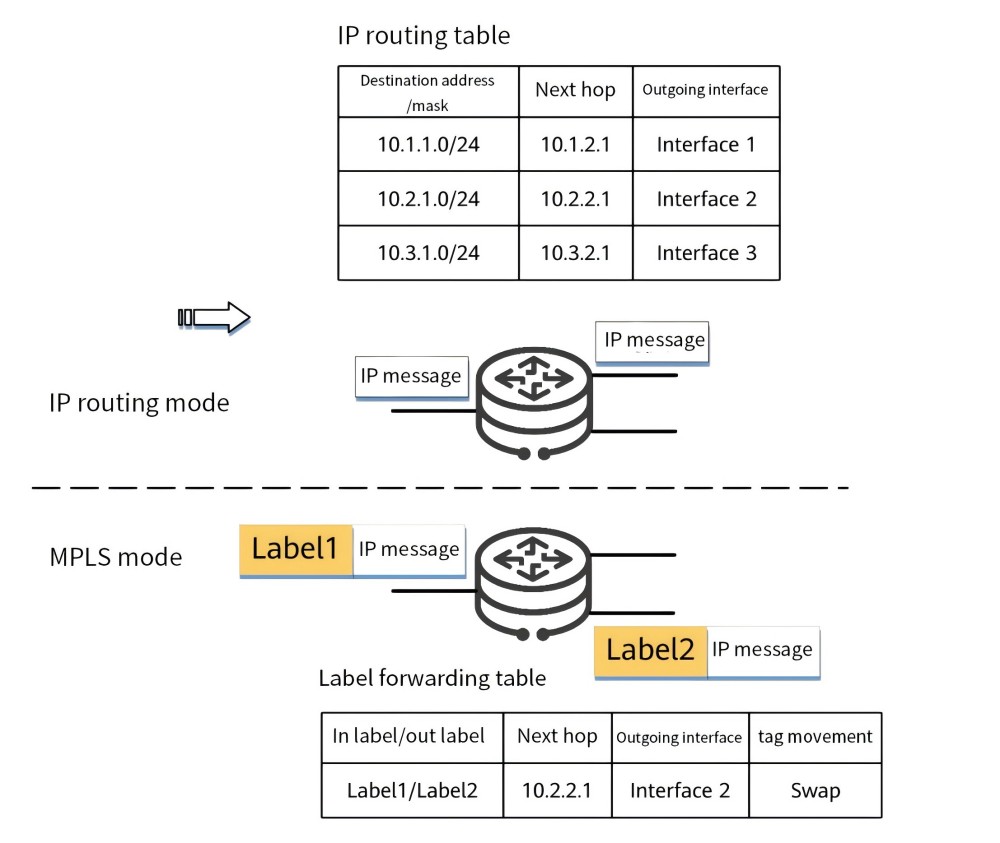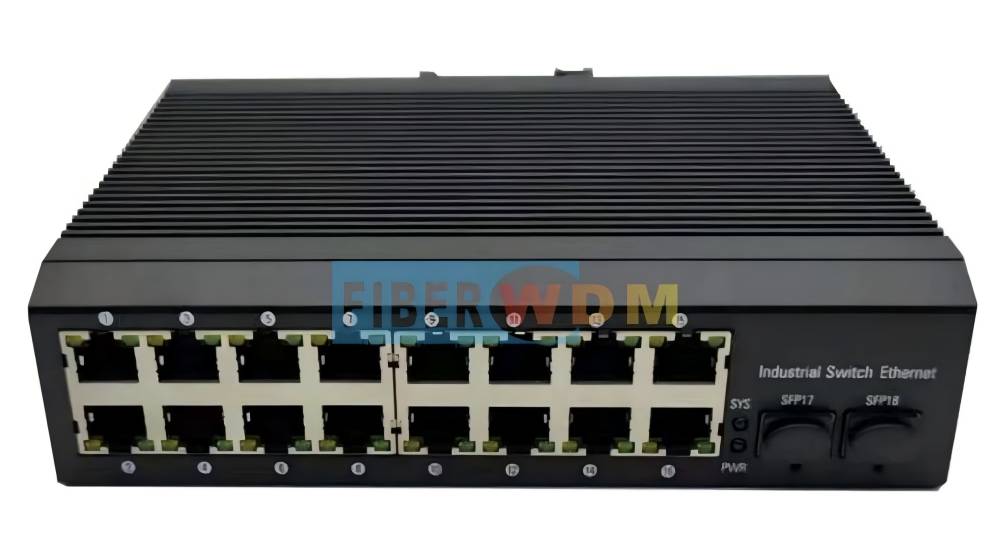241007 Description of MPLS
Oct 15, 2024
241007 Description of MPLS
(Fiberwdm All rights Reserved)
Key words: MPLS, Switch, BGP, SD-WAN
A bout MPLS
MPLS is a protocol that uses labels to forward data packets at a high speed. It is proposed by the Internet Engineering Task Force (IETF). MPLS maps IP addresses into short, fixed-length labels with local significance, and uses label exchange to replace IP table lookup, significantly improving forwarding efficiency. At the same time, the MPLS labeling mechanism can build a logical tunnel in the IP network, and MPLS is compatible with different network layer and link layer protocols. Therefore, MPLS can provide public network tunnel services for various L2VPN, L3VPN, and EVPN services.
Why need MPLS?
In the mid-1990s, with the rapid development of IP networks, the amount of Internet data increased dramatically. Due to the limitations of the hardware technology at that time, the IP technology based on the longest matching algorithm had to use the software method to find the route, and the forwarding performance was low, so the forwarding performance of IP became the bottleneck restricting the development of the network at that time. In this context, IETF proposed MPLS protocol. The original purpose of MPLS was to increase the forwarding rate of routing devices in an IP network.

Comparison of IP routing and MPLS forwarding modes
Compared with traditional IP routing, MPLS improves the forwarding rate in the following ways:
Later, with the rapid development of ASIC (Application Specific Integrated Circuit) technology, IP routing table lookup gradually changed to hardware methods, and the processing speed was greatly improved, which made MPLS no longer have obvious advantages in improving the forwarding rate of IP networks.
However, MPLS label forwarding is essentially a tunnel technology, which also supports encapsulation of multi-layer labels, and MPLS is naturally compatible with a variety of network layer and link layer protocols, so MPLS is very suitable for various VPN services as a public network tunnel. In addition, MPLS packet forwarding relies on a fixed label switching path, so MPLS is a connection-oriented forwarding technology, which makes MPLS also widely used in Traffic Engineering (TE), QoS, SD-WAN and other fields. Guangzhou Ruidong Electronic Technology Co., Ltd. developed and produced with network management industrial Gigabit switch, support IEEE technical standard protocol, support LLDP link protocol, support SP, RR, WRR, WDRR scheduling mode, support bandwidth management: Port aggregation, port mirroring, port speed limiting, support for static routing, widely used in railway, urban transportation, electric power, oil fields, coal and other industrial industries.

General keywords:
Passive wave division: CWDM,DWDM, Wavelength division Equipment, Wavelength Division multiplexer, MUX/DEMUX, high speed, the TAWG/AAWG, flat-roofed type AWG, gaussian type AWG, 100 GHZ / 200 GHZ / 50 GHZ / 75 GHZ / 150 GHZ, 40, 48 ch / 96 ch/ch / 120 ch / 64 ch / 32 ch AWG, FWDM, LWDM,MWDM,LAN-WDM, SWDM, O-band WDM, CEx-WDM, Fiber Grating reflector, Fiber grating array waveguide, Rack-mounted passive wavelength division, interleaver Comb filter, mini wavelength division module, CCWDM, Ultra MINI WDM,RAMAN WDM, Raman WDM, GPON, EPON,XGS-PON, NG-PON,XG-PON, 50G PON, FTTR
Optical fiber transmission equipment: Wavelength division transmission, 200G/400G DCI, EDFA, SOA, RFA Raman amplifier, fiber long distance transmission, OLP, optical line protection, OBP, optical bypass protection, bypass device, power cut through, fiber active/standby route protection, semi-active wavelength division, PON remote, PON aggregation remote, Optical cable detection system, 5G stretch, optical fiber expansion, DCM dispersion compensation, data center interconnection DCI, bare fiber interconnection, VOA board, dimmable attenuator, OEO/OTU board, 40G business board, 100G business board
Optical splitter: FBG taper splitter, PLC optical splitter, wave splitter, TAP-PD, multi-mode splitter, multi-mode PLC
Optical switch: mechanical optical switch, MEMS optical switch, magneto-optical switch, optical routing equipment, optical crossover, optical switching, OXC optical matrix, optical switch switching equipment
Optical module: 1X9 optical module, SFP/SFP+/XFP optical module, QSFP+40G optical module, QSFP28 100G optical module, 200G optical module, 400G optical module, 800G optical module, QSFP-DD, QSFP56, QSFP112, OSFP, AI computing power optical module, SDI optical module, HD video optical module, single transmission and single receiving optical module, wave division optical module, CWDM optical module, DWDM optical module, industrial optical module, military optical module; 25G optical module, 40G optical module, Fiberchannel, 8G/16G/32G FC optical module, 12G SDI optical module, CFP to QSFP28 conversion module
High speed cable: DAC, AOC, ACC,AEC,Mini-SAS, HDMI AOC
Integrated cabling: optical jumper, MPO/MTP jumper, armored optical jumper, base station pull high beam jumper, field cable assembly, multi-core cable jumper, ODF fiber distribution frame, fiber connector box, 144 core high density fiber distribution frame, photoelectric composite cable
Optical devices: ring actuator, passive dual fiber to single fiber, passive single multimode conversion, optical isolator, polarization-preserving device, polarization-preserving coupler, polarization-preserving circulator, polarization-preserving jumper, polarization-preserving isolator, PBC/PBS beam binder/splitter, polarization-preserving CWDM, polarization-preserving DWDM
Network security: OTAP rack-mounted splitter, TAP shunt, aggregation shunt, traffic replication, spectral replication, one-way isolation, fiber optic network card
Access equipment: Optical transceiver, protocol converter, optical fiber transceiver, photoelectric converter, PCM equipment, telephone optical transceiver, PDH optical transceiver, video optical transceiver, industrial transceiver, Industrial switch, POE switch, POE transceiver